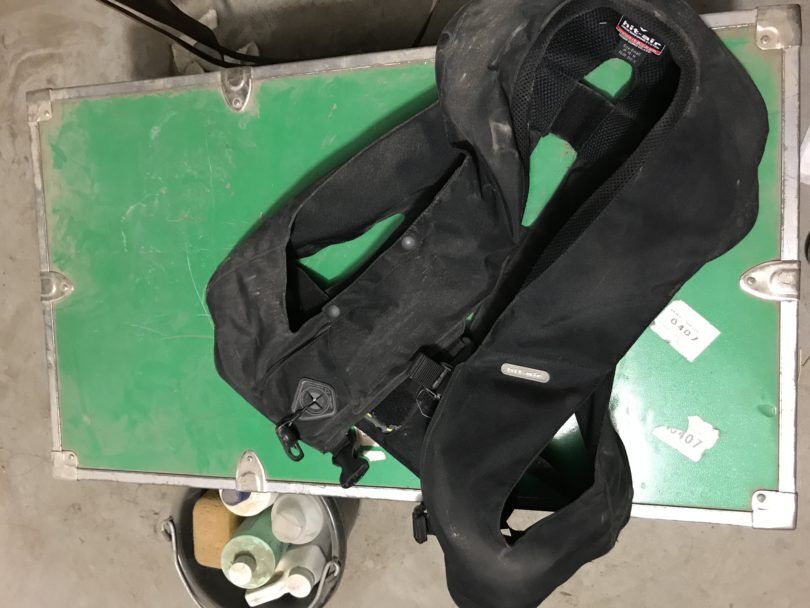Safety technology has advanced, and all of us nervous nellies should take advantage.
Horse riding can be exhilarating, but it’s not without risk. At one time or another, every rider will experience an “involuntary dismount.”
Traditional horse riding body protectors were a step in the right direction, but safety equipment has advanced to a higher level of safety with the introduction of equestrian Hit Air vests. In addition to protecting your neck, back, and internal organs, air vests can give nervous riders more brain space to focus on their riding instead of “what ifs.”
We won’t go into all the reasons riders may fall, but suffice it to say that we’ve all been there. It’s natural to feel scared, whether you’ve had a recent fall or simply worry about parting ways with your steed in the future.
From personal experience or a friend’s recounting, you know many falls can knock the wind out of you. Now, you can put the power of air to work for you vs. against you.
We love this product so much that we wrote a deep-dive equestrian Hit Air vest review about how it works, why you should try a protective vest, and frequently asked questions.
Body protectors vs. air vests
While a traditional protective riding vest helps protect your torso by absorbing impact shock (as does a horse riding helmet), equestrian air vests act like an airbag vest.
Air vests also offer more coverage than a foam body protector since they cushion your neck, back, ribs, tailbone, pelvis, and internal organs.
How do air vests work?
Once you mount, you connect the protective gear to your saddle with a little bungee cord. If you become separated from your saddle, the cord gets disconnected, and a small CO2 canister triggers vest inflation.
This equestrian safety vest inflation is lightning-fast, so by the time you hit the ground the padding is fully activated. Read a first-hand account about why my air vest resulted in my favorite fall in 30 years.
Afterward, the vest self-deflates slowly. You can then snap the expandable panels back into place, replace the CO2 canister, reattach your bungee cord, and be right back in business.
How can they help calm your nerves?
There are plenty of reasons to feel anxious about equestrian sports, but an air vest can give you gain more confidence horse riding.
Working cows in my Hit Air vest
If the memory of a past fall — or potential for a future hard landing — is holding you back, knowing you’re wearing a protective cushion helps your brain ratchet down the panic and focus on your position, balance, and mindset.
(With your brain on those key areas, you’re much less likely to fall off anyway.)
I purchased my air vest for cow work lessons, but it came in especially handy while learning to jump! If you are an who already uses , an might be something to consider.
If you’re riding with existing injuries, and the fear of hurting yourself again has you aquiver, an air vest will also help mitigate the chances of re-injury.
See why wearing an air vest made our list of 32 things you can do today to calm your riding nerves forever.
Horse Riding Safety Vest Infographic
You’re welcome to use this infographic on your own website *as long as you link back to horse-rookie.local.*
Feel free to share on Pinterest, as well by hovering over it and clicking the Pinterest icon. #knowledgeishorsepower
Learn more about equestrian safety vests.
Safe vs. sorry
No matter your discipline, skill level, or age, taking five minutes to order an equestrian Hit Air vest at Amazon could save you from an expensive trip to the emergency room and weeks or months out of the saddle recovering from an injury. (Don’t forget to wear your to prevent a !)
As if that weren’t enough incentive, an air vest provides an extra layer of comfort and security that allows you to stay mentally present and riding at your best.
If you want even more protection, you can wear your air vest over the top of a traditional body protector.
Bottom line: It’s important to stay safe and remain confident in the saddle. Wearing an air vest is one of the best ways to calm your nerves and walk away unharmed after a fall.
If you’ve also taken a tumble in an air vest, comment below to let us know about your experience!
P.S. Enjoy this article? Trot on over to:
- Equestrian Hit Air vest review: My favorite fall in 30 years
- 32 Things you can do today to calm your riding nerves forever
- Scared to ride your horse? Get your mojo back
- How can I calm my nerves before horse riding?
- What are some ways to gain confidence riding horses
- Safe or sorry: how often to replace horseback riding helmets
- Get your asana in the saddle: 5 yoga tips for equestrians
